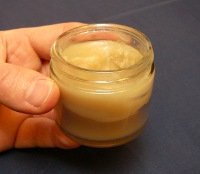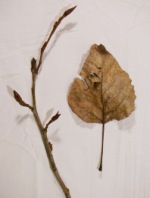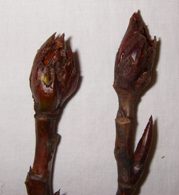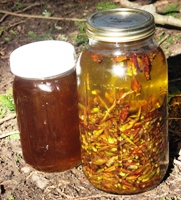How to Make Cottonwood Salve

By Jason Knight
Cottonwood salve is an amazing medicine. February and March are often the best times of year to collect the sap-filled buds of cottonwood trees for making an antiseptic, pain-relieving, skin-healing salve. The sweet-smelling sticky sap, also known as "Balm of Gilead", has been used for centuries to treat a variety of skin troubles, from cuts and scrapes to minor burns and bruises.

Black Cottonwood trees (Populus balsamifera or trichocarpa) can be found growing along rivers and in moist forests. It grows very tall and has large heart-shaped leaves with small teeth. The bark is gray and smooth on young branches and the trunk becomes deeply furrowed with age.

Cottonwoods are also known to drop branches. The tree holds so much
water, that large branches often become so heavy that they break off and
fall, especially in windstorms. After a stormy day you can usually find
quite a few downed cottonwood branches, loaded with spring buds.
Pick the buds that are large and swollen. They often glisten with sap and will break off from the branch easily.
At this time of the year the aromatic sap is filling the buds. The sap
contains a variety of medicinal components, including compounds that
kill germs, ease pain, and promote skin regeneration. I often refer to
the sap as the "skin ointment of the woods". In a pinch it can be used
straight from the bud.

The difficulty in working with the sap directly is that it is extremely sticky (somewhat similar to pine sap). One of the best ways to extract the medicinal qualities of the sap is to infuse the buds in an oil. The oil can then be used as it is or turned into a cottonwood salve.
To make cottonwood oil, fill a quart-sized glass jar about 2/3 of the way full with buds. Then fill the jar up to the top with olive oil (I prefer olive oil as it does not spoil easily). Put a lid on the jar and put the jar on a plate or bowl. Some oil often seeps out during the curing process.

Let the jar of buds and oil sit for two to twelve months. Stir every few weeks if you get the chance, and make sure the buds stay covered by the oil (exposed buds will mold). When you are ready you can strain the oil through a cheesecloth. It will have that characteristic sweet cottonwood scent. You can now use the oil directly on scrapes, bruises, and minor burns, or turn the oil into a salve.
Now that you have created cottonwood oil, you can use the following recipe to create your very own medicinal salve. The advantages of a salve is that the medicine is turned into an ointment consistency that better adheres to skin and can be carried easily for first aid uses in the field.
Be More Prepared For Your Next Outdoor Adventure!

Don't leave home without knowing these six essential survival skills. Our free survival mini guide reveals the strategies of:
- Shelter & fire to prevent the number one cause of death
- Obtaining clean water to avoid life-threatening dehydration
- Common wild survival foods and other critical skills!

Cottonwood Salve Recipe
1 cup of cottonwood oil
1/4 cup of shaved beeswax
First, choose a pot or pan that you don't mind dedicating to
salve-making, as the medicine will be very difficult to completely
remove. Heat up your cottonwood oil on the stove on low heat. You can
even use a double-boiler to further protect the oil from getting too
hot, though it is not necessary. Once the oil has warmed up, slowly add
the thin shavings of beeswax into the pot (a cheese grater can be used to shave a block of beeswax), waiting for shavings to melt
before adding more.
You can test the consistency of your medicine by removing a teaspoon of
the heated oil/beeswax mix, and allowing it to fully cool. Your goal is
to create an ointment consistency. Too little beeswax and the mixture
remains as a thick oil, while too much beeswax turns the mix into a hard
consistency similar to lip balm. You can adjust by adding more oil or
beeswax to gain the desired consistency.

Once you have melted your beeswax into the mix and achieved the desired
consistency upon testing, you can allow the mix to begin to cool. Just
before your salve begins to firm up, you can pour the warm salve into
small containers such as baby food jars or small tins. Your salve will
then cool down into place. The small containers of cottonwood salve make
great gifts and additions to first aid kits.
You can now use the salve to sooth sore muscles, treat minor burns and scrapes, and soften rough hands. Enjoy!
By the way, when you're out foraging, it's important to know how to stay safe in the outdoors, especially if you were to get lost. Right now you can get a free copy of our mini survival guide here, where you'll discover six key strategies for outdoor emergencies, plus often-overlooked survival tips.
Recommended Resources:
Making Balm of Gilead - LearningHerbs
Related Courses:
Wild Edible and Medicinal Plants Courses at Alderleaf

About the Author: Jason Knight is a cofounder of Alderleaf Wilderness College and the author of The Essential Skills of Wilderness Survival. He has been teaching wilderness skills for over twenty-five years. Learn more about Jason Knight.
Return from How to Make Cottonwood Salve back to Plants Articles
Is The Essential Wilderness Survival Skills Course Right for You? Take the "Online Survival Training Readiness" Quiz
See for yourself if this eye-opening course is a good fit for you. It takes just a few minutes! Get your Survival Training Readiness Score Now!

Grow Your Outdoor Skills! Get monthly updates on new wilderness skills, upcoming courses, and special opportunities. Join the free Alderleaf eNews and as a welcome gift you'll get a copy of our Mini Survival Guide.

 The Six Keys to Survival: Get a free copy of our survival mini-guide and monthly tips!
The Six Keys to Survival: Get a free copy of our survival mini-guide and monthly tips!
Learn more